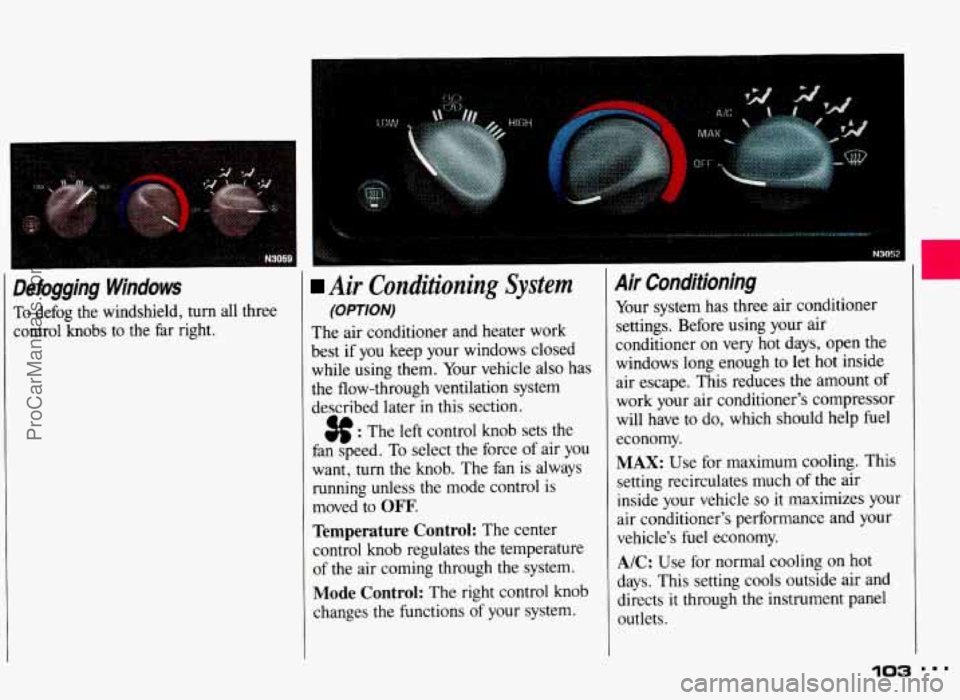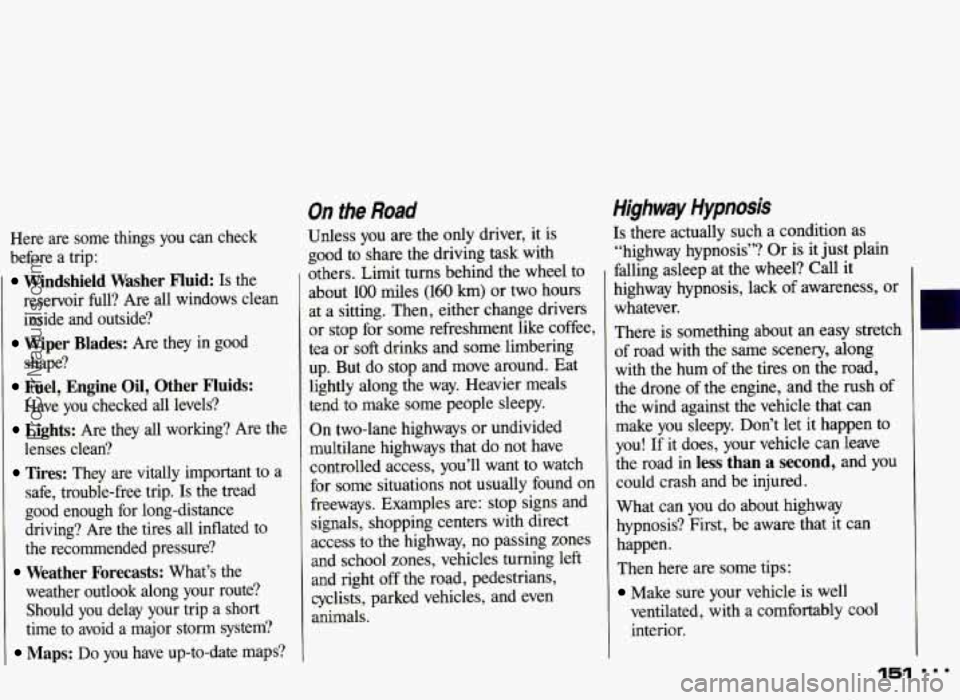1993 PONTIAC GRAND-AM window
[x] Cancel search: windowPage 70 of 306

I
Power Window Lock-Out Switch
(OPT/Off)
On 4-door models, this switch disables
all passenger power windows. Push the
switch forward to lock the windows.
Push the switch back to unlock the
windows.
Turn SignallHeadlight
Beam
Lever
The lever on the left side of the steering
column includes your:
Turn Signal and Lane Change
Headlight High-Low Beam Changer
Flash-to-Pass Feature
Cruise Control (Option)
The High-Low Beam feature is
discussed under
Headlights. See the
Index under Headlights.
Indicator
Turn Signa/ and Lane Change
lndicator
The turn signal has two upward (for
Right) and two downward (for Left)
positions. These positions allow you to
signal a turn or a lane change.
To signal a turn, move the lever all the
way up or down. When the turn is
finished, the lever will return
automatically.
A green arrow on the instrument panel
will flash in the direction of the turn
or
lane change.
ProCarManuals.com
Page 88 of 306

The lnstrument Panel-
bur Information System
Your instrument panel is designed to let
you know at a glance how your vehicle
is running. You’ll know how fast you’re going, how much fuel you’re using, and
many other things you’ll need to drive
safely and economically.
The main components
of your
instrument panel are:
1. Fog Light Switch
2. Instrument Panel Intensity
3. Side Vent
4. Turn SignaUHeadlight Beam Lever Control/Interior Lights Switch
5. Hazard Warning Flashers Switch
6. Instrument
Cluster
7. Windshield Wiper/Washer Stalk
8. Center Vent
9. Audio System
1 0. Side Vent
1 1. Side Window Defogger Vent
12. Glove Box
1 3. Climate Control System
14. Ashtray/Lighter
15. Gear Shift Lever
16. Rear Window Defogger (Option)
17. Ignition Switch
18. Horn
1 9. Tilt Steering Wheel Lever (Option)
20. Parking Brake Release Lever
21. Hood Release Handle
22. Fuse Panel
I
ProCarManuals.com
Page 104 of 306

Defogging Windows
To defog the windshield, turn all three
control knobs to the far right.
I
I
Air Conditioning System
(OPTION)
The air conditioner and heater work
best if you keep your windows closed
while using them. Your vehicle also has
the flow-through ventilation system
described later
in this section.
3f : The left control knob sets the
fan speed. To select the force
of air you
want,
turn the knob. The fan is always
running unless the mode control is
moved to
OFF.
Temperature Control: The center
control knob regulates the temperature
of the air coming through the system.
Mode Control: The right control knob
changes the functions
of your system.
Air Conditioning
Your system has three air conditioner
settings. Before using your air
conditioner on very hot days, open the
windows long enough
to let hot inside
air escape. This reduces the amount
of
work your air conditioner's compressor
will have to do, which should help fuel
economy.
MAX: Use for maximum cooling. This
setting recirculates much
of the air
inside your vehicle
so it maximizes your
air conditioner's performance and your
vehicle's fuel economy.
A/C: Use for normal cooling on hot
days. This setting cools outside air and
directs it through the instrument panel
outlets.
103
ProCarManuals.com
Page 105 of 306

Comfort Controls & Audio Systems
Air Conditionina (CONI) -.
qg (Bi-Level): Use on cool, but
sunny days. This setting brings in the
outside air, but directs it in two ways.
The cool air is directed to the upper
portion of your body through the
instrument panel outlets, but slightly
warmer air is directed through the
heater ducts and defroster vents. At
times this temperature difference may be
more apparent than others.
The air conditioner compressor operates
in all three air conditioning positions. It
also operates in (Defrost) when
the outside temperature is higher than
about
40°F (4.5"C).
Ventilation
Use when outside temperatures are
mild, and little heating or cooling is
needed. Turn the right control knob to
2 (Vent). Air flow is directed
through the instrument panel outlets. Set
the center control knob to the
temperature desired.
Heating
Turning the right control knob to
72 (Heater) and the center control
knob clockwise will send heated air
through the heater ducts, and some
through the defroster vents.
3 (Vent) and (Heater) are
economical positions because the air
conditioner compressor doesn't run in
these two settings. This reduces engine
load, resulting in improved fuel
economy. If either setting fails to keep you
comfortable, or causes your windows
to fog up, turn the right control knob to
one of the air conditioning positions, or
to
(j@ (Defrost).
If you have the optional engine block
heater and use it during cold weather,
0°F (-18°C) or lower, your heating
system will more quickly provide heat
because the engine coolant is already
warmed. See the
Index under Engine
Block Heater.
flow equally between the heater ducts
and the windshield defroster vents.
vg (Blend): This setting divides air
Defrosting
The (@ (Defrost) setting directs most
air through the defroster vents, and
some through the heater ducts.
8.8 104
ProCarManuals.com
Page 106 of 306

I
Defogging Windows with
Air Conditioning System
To defog the windshield, turn all three
control knobs to the far right. To defog
the side windows, turn the
right control knob to 12 (Bi-Level)
and the fan control knob to
HIGH. Aim
the side vents toward the side windows.
For increased air flow to the side vents,
close the center vents.
Rear Window Defogger (OPTION)
The rear window defogger uses a
warming grid to remove fog from the
rear window. Press
the defogger switch.
The indicator light will glow.
If your
vehicle is traveling under
45 mph
(70 kmlh), the rear window defogger
will turn off automatically after about
10 minutes of use. If your vehicle is
traveling over
45 mph (70 km/h), the
defogger will operate continuously. You
can
turn the defogger off by turning off
the ignition or pressing the switch again.
Do not attach a temporary vehicle
license across the defogger grid
on the
rear window.
105 ...
................. * N3054
ProCarManuals.com
Page 107 of 306

Comfort Controls & Audio Systems
I
Rear Window Defogger (CONT.:) I Flow-Through Ventilation System
Don’t use a razor blade or something
else
sharp on the inside of the rear
window. If you do,
you could cut
or damage the warming grid, and
the repairs wouldn’t be covered by
your warranty Your Pontiac’s
flow-through ventilation
system supplies outside air into the
vehicle when it is moving. Outside air
will also enter the vehicle when the
heater or the air conditioning fan is
running.
Ventilation Tips
Keep the hood and front air inlet free
of ice, snow, or any other obstruction
(such as leaves). The heater and
defroster will work far better, reducing the chance of fogging the inside of
your windows.
When you enter a vehicle in cold
weather,
turn the fan control knob to
HIGH for a few moments before
driving off. This helps clear the intake
ducts of snow and moisture, and
reduces the chance of fogging the
inside of your windows.
clear of objects. This helps air to
circulate throughout your vehicle.
Keep the air path under the front seats
ProCarManuals.com
Page 126 of 306

REVERSIBLE tANE ON MULTtlANE ROADWAY
Many city roads and expressways, and
even bridges, use reversible-lane traffic
control during rush hours.
A red X light
above a lane means no driving in that
lane at that time.
A green arrow means
you may drive in that lane. Look for the
signs posted to warn drivers what hours
and days these systems are in effect.
NO PASSING ZONE
Pavement Markings
Pavement markings add to traffic signs
and signals. They give information to
drivers without taking attention from the
roadway.
A solid yellow line on your
side of the road or lane means
Don’t
Cross.
bur Own Signals
Drivers signal to others, too. It’s not
only more polite, it’s safer to let other
drivers
know what you are doing. And
in some places the law requires driver
signals.
Turn and Lane Change Signals:
Always signal when you plan to turn or
change lanes.
If necessary,
you can use hand signals
out the window:
Left arm straight out
for
a left turn, down for slow or about-
to-stop, and up for a right turn.
Slowing Down: If time allows, tap the
brake pedal once or twice
in advance of
slowing
or stopping. This warns the
driver behind you.
Disabled: Your four-way flashers signal
that your vehicle is disabled
or is a
hazard. See the
Index under Hazard
Warning Flashers.
liffk Ofiiceer
The traffic police officer is also a source
of important information. The officer’s
signals govern, no matter what the
traffic lights or other signs
say.
The next section discusses some of the
road conditions you may encounter.
125
ProCarManuals.com
Page 152 of 306

Here are some things you can check
before a trip:
Windshield Washer Fluid: Is the
reservoir full? Are all windows clean
inside and outside?
shape?
Have you checked all levels?
lenses clean?
safe, trouble-free trip.
Is the tread
good enough for long-distance
driving? Are the tires all inflated to
the recommended pressure?
weather outlook along your route? Should you delay your trip a short
time to avoid a major storm system?
Maps: Do you have up-to-date maps?
Wiper Blades: Are they in good
Fuel, Engine Oil, Other Fluids:
Lights: Are they all working? Are the
Tires: They are vitally important to a
Weather Forecasts: What’s the
On the Road
Unless you are the only driver, it is
good to share the driving task with
others. Limit
turns behind the wheel to
about
100 miles (160 km) or two hours
at a sitting. Then, either change drivers
or stop for some refreshment like coffee,
tea or
soft drinks and some. limbering
up. But do stop and move around. Eat
lightly along the way. Heavier meals
tend to make some people sleepy.
On two-lane highways or undivided
multilane highways that do not have
controlled access, you’ll want to watch
for some situations not usually found on
freeways. Examples are: stop signs and
signals, shopping centers with direct
access to the highway, no passing zones
and school zones, vehicles turning left
and right off the road, pedestrians,
cyclists, parked vehicles, and even
animals.
Highway Hypnosis
Is there actually such a condition as
“highway hypnosis”? Or is it just plain
falling asleep at the wheel?
Call it
highway hypnosis, lack of awareness, or
whatever.
There is something about an easy stretch
of road with the same scenery, along
with the hum of the tires on the road,
the drone of the engine, and the rush
of
the wind against the vehicle that can
make you sleepy. Don’t let it happen
to
you! If it does, your vehicle can leave
the road
in less than a second, and you
could crash and be injured.
What can you do about highway
hypnosis? First, be aware that it can
happen.
Then here are some tips:
Make sure your vehicle is well
ventilated, with a comfortably cool
interior.
151 ...
ProCarManuals.com